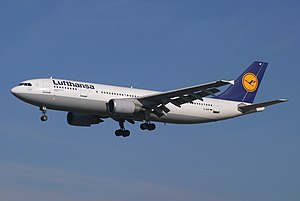
Back Airbus A300 Afrikaans Airbus A300 AN إيرباص إيه 300 Arabic Еърбъс А300 Bulgarian Airbus A300 Catalan Airbus A300 Czech Airbus A300 Danish Airbus A300 German Airbus A300 Greek Airbus A300 Esperanto
| Airbus A300 | |
|---|---|
 | |
| The A300 has two underwing podded turbofans, making it the first twinjet wide-body airliner. Seen here operated by Lufthansa in 2004. | |
| General information | |
| Role | Wide-body airliner |
| National origin | Multi-national |
| Manufacturer | Airbus |
| Management and usage | FedEx Express |
| Number built | 561[1] |
| History | |
| Manufactured | 1971–2007 |
| Introduction date | 23 May 1974 with Air France |
| First flight | 28 October 1972 |
| In service | 1974–present[a] |
| Developed into | |
| Variations | A300-600ST Beluga |
The Airbus A300 is Airbus's first production aircraft and the world's first twin-engine, double-aisle wide-body airliner, developed and manufactured by Airbus from 1971 to 2007.
In September 1967, aircraft manufacturers in the United Kingdom, France, and West Germany signed an initial memorandum of understanding to collaborate to develop an innovative large airliner. West Germany and France reached a firm agreement on 29 May 1969, after the British withdrew from the project on 10 April 1969. The pan-European collaborative aerospace manufacturer Airbus Industrie was formally created on 18 December 1970 to develop and produce it. The A300 prototype first flew on 28 October 1972.
The first twin-engine widebody airliner, the A300 typically seats 247 passengers in two classes over a range of 5,375 to 7,500 km (2,900 to 4,050 nmi; 3,340 to 4,660 mi). Initial variants are powered by General Electric CF6-50 or Pratt & Whitney JT9D turbofans and have a three-crew flight deck. The improved A300-600 has a two-crew cockpit and updated CF6-80C2 or PW4000 engines; it made its first flight on 8 July 1983 and entered service later that year. The A300 is the basis of the smaller A310 (first flown in 1982) and was adapted in a freighter version. Its cross section was retained for the larger four-engined A340 (1991) and the larger twin-engined A330 (1992). It is also the basis for the oversize Beluga transport (1994).
Unlike most Airbus products, it has a yoke rather than a sidestick, and does not use a fly-by-wire system.
Launch customer Air France introduced the type on 23 May 1974. After limited demand initially, sales took off as the type was proven in early service, beginning three decades of steady orders. It has a similar capacity to the Boeing 767-300, introduced in 1986, but lacked the 767-300ER range. During the 1990s, the A300 became popular with cargo aircraft operators, as both passenger airliner conversions and as original builds. Production ceased in July 2007 after 561 deliveries. As of September 2023[update], there are 197 A300 family aircraft still in commercial service.
Cite error: There are <ref group=lower-alpha> tags or {{efn}} templates on this page, but the references will not show without a {{reflist|group=lower-alpha}} template or {{notelist}} template (see the help page).